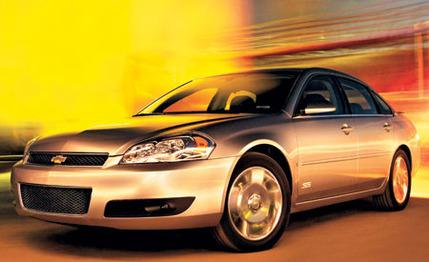 Road Test
Road Test
There's an internal fight going on in the Impala SS, an existential struggle between the car's performance and family duties that is glaringly apparent with the first turn of the wheel. Neither personality emerges as the dominant one, and the result is a car that feels unfinished and confused as to its purpose.
After stepping out from behind the wheel, the driver can't help being impressed by the SS's power and its ability to generate astonishing numbers - 0 to 60 in 5.6 seconds, for one. The SS seems to have been created to produce impressive numbers on paper with little regard to driver enjoyment.
Redesigned inside and out for 2006, the Impala rides on GM's front-drive W-body platform that is the basis for the Buick LaCrosse, Pontiac Grand Prix, and Chevy Monte Carlo. Substantial tweaks and engineering sweat have been poured into the platform since it debuted 18 years ago as the GM10. This year's biggest news would have to be the availability of a small-block V-8 in the Impala SS, Monte Carlo SS, and Grand Prix GXP ( C/D, October 2005). The current front-drive Impala SS is not to be confused with the rear-drive body-on-frame beasty that was sold for three years in the mid-'90s.
Keeping an 18-year-old platform competitive is not an insubstantial task. The many adjustments and changes are, for the most part, well placed and largely successful. For example, GM engineers worked hard to exorcise torque steer, and despite being hamstrung by a front-drive platform with unequal-length driveshafts and a small-block 5.3-liter aluminum V-8 with 303 horsepower and 323 pound-feet of torque (43 more horses than the mid-'90s rear-drive Impala SS and 63 more horses than last year's supercharged SS), they put up a good fight.
However, they didn't repeal any laws of front-drive physics. The SS has so much power going to its front tires that when the traction control is engaged, the tires hunt for grip and the steering wheel tugs sharply to the left or right. The culprit is the traction control. As it engages each front brake to combat slip, torque is sent back and forth between the tires. We thought it was torque steer until Mark Clawson, the Impala's marketing manager, pointed out that if you switch off the traction control, the car will spin the front tires with nary a twitch from the leather-wrapped wheel. However, this only occurs on billiard-table-smooth roads with the car pointed straight ahead; the slightest imperfection or steering input sets the tires on different missions, and the car gives the feeling that it's waging war with itself.
Despite the antics of the overwhelmed tires, hard acceleration still leaves the driver giddy - at least for the first few runs. We certainly can't argue with this kind of performance from a family sedan that starts at $26,990 - there's that 0-to-60 time of 5.6 seconds, the quarter-mile turns in 14.2 seconds at 101 mph, and the ungoverned top speed is 154 mph. Much to our surprise, the SS turned out to be 0.1 second faster from 0 to 60 and in the quarter-mile than the identically powered but 132-pounds-lighter Grand Prix GXP we tested last fall.
The SS's quicker acceleration can likely be traced to its shorter final-drive ratio (3.29:1 vs. 2.93). It's also interesting to note that this level of acceleration is accomplished with a four-speed automatic - that's called making the most of what you've got. But despite this performance, the Impala isn't convincing as a sports sedan.
Part of the reason the Impala SS feels so uncomfortable with the V-8's power is that it doesn't benefit from all the chassis tweaks bestowed on the Grand Prix GXP. Opt for the Chevy, and you don't get the Pontiac's wider front wheels and sticky Bridgestone tires, Bilstein shocks, and larger brakes. Although the SS's chassis gets its own special anti-roll bars, bushings, and shock and spring rates, the suspension simply monkeys around too much. Any sporting input is foiled by a mess of undamped and uncontrolled body motions. Dive, squat, and roll control could be described as nautical. Hit the firm, easily modulated brake pedal hard, and the SS's nose dives toward the pavement. A stop from 70 mph used up only 172 feet, a couple of feet better than the larger-braked GXP could muster.
On the skidpad, the SS clung to the tune of 0.81 g - only 0.01 g less than the summer-tire-equipped GXP. Reality: The Impala leaned over far enough to be included in Who's Who in Body Roll. Making the roll feel even more pronounced are flat, unsupportive, and slippery leather seats that require the driver to brace against the door.
One upside of the flabbiness is that the highway ride is compliant and never jarring; unfortunately, the Jell-O-like suspension keeps the body moving, and speed only exacerbates the problem. Impressed by the 154-mph top speed? Driving the SS at that speed is scary enough to be a stunt on NBC's Fear Factor. Judged by the numbers, the SS looks like high performance, but experience tells another story.